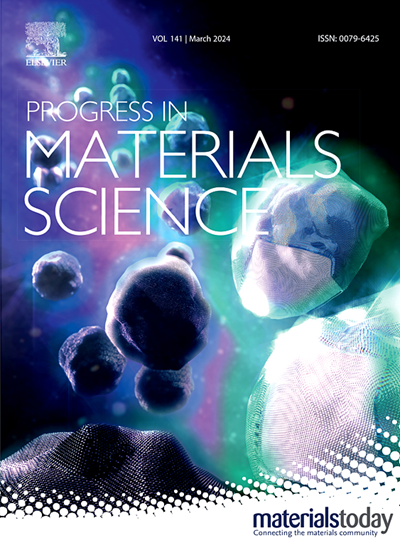Additively manufactured function-tailored bone implants made of graphene-containing biodegradable metal matrix composites
IF 40
1区 材料科学
Q1 MATERIALS SCIENCE, MULTIDISCIPLINARY
引用次数: 0
Abstract
While conventionally manufactured metallic biomaterials can hardly meet all the requirements for bone implants including complex geometry, exact dimensions, adequate biodegradability, bone-matching mechanical properties, and biological function, two additional tools have recently appeared in the arsenal of biomaterials scientists which promise to deliver the desired combination of properties. First, the unique mechanical, electrical, and biological properties of graphene (Gr) and its derivatives (GDs), e.g., a Young’s modulus up to 1 TPa, can be utilized to create metal matrix composites in which GDs of varied contents (typically not more than 2 wt%), sizes (lateral sizes from a few nanometers to several micrometers), surface areas (up to the theoretical value of 2630 m2/g), and layer numbers (typically up to 10) are embedded in the biodegradable metal matrix, thereby endowing the composite implants with extraordinary properties. Second, the distinct advantages of additive manufacturing (AM) make it possible for GD-containing composite materials to precisely mimic the complex shapes and structures of bones at multiple length scales. Here, a comprehensive review of the recent advances in the development of GD-containing biodegradable metal matrix composites (GBMMCs), ranging from composite fabrication, including composite powder preparation, and AM processes, to the evaluation of AM composites in terms of their mechanical and biological properties, is presented. Furthermore, the constraints in processing composite powders, the advantages and disadvantages of applicable AM techniques, and the mechanisms of mechanical reinforcement, biodegradation modulation, osteogenesis improvement, and cytotoxicity/antibacterial balance are critically analyzed. Thereafter, the foreseeable challenges faced in the development of the next-generation of bone implants based on GBMMCs are presented and some future directions of research are identified.
增材制造的功能定制骨植入物由含石墨烯的可生物降解金属基复合材料制成
虽然传统制造的金属生物材料很难满足骨植入物的所有要求,包括复杂的几何形状、精确的尺寸、足够的生物降解性、骨匹配的机械性能和生物功能,但最近在生物材料科学家的武器库中出现了两种额外的工具,它们承诺提供所需的性能组合。首先,石墨烯(Gr)及其衍生物(GDs)独特的机械、电气和生物特性,例如高达1 TPa的杨氏模量,可用于制造金属基复合材料,其中不同含量的GDs(通常不超过2 wt%)、尺寸(横向尺寸从几纳米到几微米)、表面积(高达理论值2630 m2/g)和层数(通常高达10层)嵌入在可生物降解的金属基体中。从而赋予复合植入物非凡的性能。其次,增材制造(AM)的独特优势使含gd的复合材料能够在多个长度尺度上精确模拟骨骼的复杂形状和结构。本文综述了含gd的可生物降解金属基复合材料(GBMMCs)的最新进展,从复合材料的制备,包括复合粉末的制备,AM工艺,到AM复合材料的力学和生物性能的评价。此外,本文还分析了复合粉末的加工限制,适用AM技术的优缺点,以及机械增强,生物降解调节,骨生成改善和细胞毒性/抗菌平衡的机制。在此基础上,提出了基于gbmmc的下一代骨种植体发展中可预见的挑战,并指出了未来的研究方向
本文章由计算机程序翻译,如有差异,请以英文原文为准。
求助全文
约1分钟内获得全文
求助全文
来源期刊

Progress in Materials Science
工程技术-材料科学:综合
CiteScore
59.60
自引率
0.80%
发文量
101
审稿时长
11.4 months
期刊介绍:
Progress in Materials Science is a journal that publishes authoritative and critical reviews of recent advances in the science of materials. The focus of the journal is on the fundamental aspects of materials science, particularly those concerning microstructure and nanostructure and their relationship to properties. Emphasis is also placed on the thermodynamics, kinetics, mechanisms, and modeling of processes within materials, as well as the understanding of material properties in engineering and other applications.
The journal welcomes reviews from authors who are active leaders in the field of materials science and have a strong scientific track record. Materials of interest include metallic, ceramic, polymeric, biological, medical, and composite materials in all forms.
Manuscripts submitted to Progress in Materials Science are generally longer than those found in other research journals. While the focus is on invited reviews, interested authors may submit a proposal for consideration. Non-invited manuscripts are required to be preceded by the submission of a proposal. Authors publishing in Progress in Materials Science have the option to publish their research via subscription or open access. Open access publication requires the author or research funder to meet a publication fee (APC).
Abstracting and indexing services for Progress in Materials Science include Current Contents, Science Citation Index Expanded, Materials Science Citation Index, Chemical Abstracts, Engineering Index, INSPEC, and Scopus.
 求助内容:
求助内容: 应助结果提醒方式:
应助结果提醒方式:


